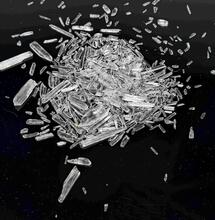Better Buds with Mr. Bill: Your Lights Directly Control Your Yield, Part II

Our expert Cannabis grower, Mr. Bill, shares some essential information about light positioning, distribution of light and yield.
Our expert Cannabis grower, Mr. Bill, shares some essential information about light positioning, distribution of light and yield.
Mr. Bill is ready to assist you by drawing upon over twenty-eight years of active grow shop experience - including answering growers' questions about the hydroponic industry. Before Mr. Bill opened his first store he worked in the agricultural industry for five years, growing tobacco.
|
Particle agitation is sometimes not as effective at the ends of the light tube, so the output is usually stronger towards the center of the lamp |
How Do Grow Lamps Work?
Artificial light is produced by agitating different chemicals inside a vacuum tube with high voltage; when these chemicals glow, the light is dispersed in a 360-degree direction from the source. This allows light to travel in all directions, except for where there are obstructions at the top and bottom of each arc tube.
Particles that are agitated close to the glass arc tube will send light towards the obstruction and, in some cases, miss providing light towards the ends. When reading a light meter, the light that is five inches directly below the arc tube obstruction at each end of the tube is about half the amount of light coming out six inches straight over to the side.
Reflect Light Properly
The location of the reflective wall that will contain the light in your garden is very important. If the room that you are setting up is larger than the grow space, you must trap the light in the growing area by using a reflective wall. Most professional growers use a reflective white paint, rather than Mylar or similar shiny, silver-colored products. If you do not erect walls for this purpose, you would be forced to illuminate the walkways and the rest of the room, which would be a total waste of light and electric energy.
Place reflective walls at a distance of six inches away from ebb-and-flow gardens. Ebb-and-flow tables are usually four feet wide and erecting reflective walls six inches away from the edge allows for plants to bush out and for air to flow up and through the sides of garden.
If you plan on growing larger plants, erect reflective walls at five-foot centers per 1000 watts: at five-by-five feet, use one light; at ten-by-five, use two lights; for fifteen-by-five, use three lights; for a ten-by-ten space, use four lights, and so on.
|
These lamps are air-cooled, assisting in removing hot air from the grow space; the white walls are highly reflective to prevent loss of light |
Be Efficient in Your Lighting Scheme
Set up your lights so that you provide even light distribution throughout your garden. Check with the light meter to make sure that you have no hot spots.
Before placing your plants under lights, place your bare hands where the plant canopy will be. If you cannot leave your hands there for very long, the plants will probably be uncomfortable. A basic way to think about this is, if you feel hot or cold, sweaty or clammy, and want to get out of your room fast because you are uncomfortable, your plants are probably uncomfortable also, but they cannot leave the grow room. Not correcting ventilation and light distance from the plants is a sure way to lower the garden's yield.
Did you know that, just by burning lamps horizontally, light is lost? Ten percent of the output of a lamp is lost just through burning position. Twenty-five percent of the lamp's life is also lost; many growers adjust for loss-of-life by replacing the light after three-quarters of a year's usage, for optimal output.
When burning lamps horizontally, about one-third of the light may go directly towards the plant canopy and about two-thirds of the light emitted from the lamp bounces around in the horizontal reflector. Now, depending upon the quality of the material used to make the reflector, you could lose even more light. If the reflector material is rated at ninety-two-percent reflective, this is another loss of light: two-thirds of light lost, plus another eight percent. If the reflector has glass built into it, another three to five percent of light is lost to the reflector material. To further calculate: 1000 watts loses ten percent, or 100 watts; two-thirds of 1000 watts is 666.66 watts of light energy that is being affected. If we lose eight percent, plus three percent, that is eleven percent of 666.66, which equals 73.33; 100 watts plus 73.33 equals 173.33 watts of light that simply disappears - that is almost a fifth of your yield destroyed just by lamp orientation.
There are other factors affecting light loss from horizontal burning positions. One example is wave cancellation. When light is redirected back into itself, it will be lost from wave cancellation. It is very difficult to understand this because light energy has a very small bandwidth - mere nanometers. Since light is created at timing intervals that cannot be discerned with the naked eye, it seems to be continuous.
Exactly how much light is lost when light is bounced back at itself, we do not know, but there is a definite loss of light. Also, the elements that are used in lamps where they are agitated by electricity, especially the salts, are a factor.
Since we pay for artificial light, we should not waste it. Light meters are a very valuable piece of equipment. It is also essential to position lamps the correct distance from the plants.
The following is a rough guide to placing your light source at the correct height above the Cannabis canopy.
LED Lights: Very close to plants
Fluorescents: Three inches away
Compact Fluorescents: Three inches away
Sulphur Bulbs: Eighteen inches away
Induction Lighting: Fourteen to eighteen inches away
High Intensity Discharge Lights:
1000 Watts: Twelve to eighteen inches away
600 Watts: Eight to sixteen inches away
400 Watts: Eight to sixteen inches away
250 Watts and Lower: As close as possible
*Other light sources do not work very well
What are the Optimal Lights to Use for Flowering Cannabis?
High-pressure sodium (HPS) and metal halide (MH) lamps are perhaps the most readily-available and reliable. As you experiment and get closer to choosing one light source or the other, you will notice a difference in results between types and brands. The best and healthiest plants will often be the ones that are located in between the lights. As you move away from the center of the light footprint, you will see noticeable differences in the quality and development of certain plants.
When the sun rises each morning and sets each night, the color spectrum will have a reddish cast - HPS lamps are strong in the red spectrum - which stimulates the plants to start working each day. As the day progresses, the sun's color shifts to a bluish spectrum; as the day ends, the sun takes on a reddish color spectrum again. Springtime has more reds in early morning, as does the autumn. As summer passes through, the colors change from more blues earlier in the day to more reds. These colors stimulate plants to start growth and flowering.
Since plants have evolved over hundreds of millions years, it is best to copy as much of this natural phenomenon as possible. To prove this, just take a look at the sun early in the morning, and again in the evening - the sun, when low to the horizon, has a reddish hue to it. This red stimulates plants, informing them of the changing seasons, along with the day's length, temperatures and dry or wet season.
For vegetating (growing) plants, the daylight 5K metal halide lamps 5 K produce the best light. Leaves will be larger and healthier than under regular MH lamps. Many growers do not know that there is a difference in the output of MH lamps, such as the MHS 125,000 MH/U universal burning position or MH 90,000 initial lumens output.
Six T5 fluorescent tubes are better for vegetative growth of plants than a 400-watt MH lamp. T5 lamps have a better color spectrum than MH and create less of a difference in temperature between 'day' and 'night.' The light ('day') period should be warmer than grow room temps at 'night;' optimally, growers should average a difference of about ten degrees Fahrenheit between light and ark temperatures, or extra elongation (known as 'stretching') between the internodes will happen. This causes plants to become too tall and lean, not short and bushy.
How to Prepare for a New Lighting Setup
Before planning a lighting scheme, it is essential to remember how light travels and bounces around within your growing area. When using multiple lamps, it is extremely important to achieve even light distribution over your plants. Plants that receive different amounts of light will grow differently from each other. As long as light is delivered to the plants with even coverage, they will grow quite similarly to each other.
|
Insufficient exhaust/ventilation, too many lights and placing the lamps too close to the plants may all lead to wilting or damage from excessive heat |
It is also extremely important to choose plants from seedlings or cuttings that will growing evenly and consistently. Otherwise it would become quite difficult to illuminate them evenly and to get them to grow at similar rates - you do not want tall and short plants under the same lights. When growing seeds alongside cuttings, cuttings will nearly always outgrow the seedlings. Try to make each clone or cutting the same size and, when rooted, choose only the cuttings that are all similar in vigor and size.
Before placing plants into grow room, take a light meter and pass it along where the two light sources meet and try to adjust lamp placement until even light distribution is achieved - this is easier with vertical lights than horizontal lighting.
Another important factor is heat; lights produce heat and with extra lights it is especially important that we do not cook the growing tips of plants. As mentioned in Part I, place your hands under the lamps, about where the top of the plant canopy will be situated, and leave them there for a few minutes. If your skin becomes uncomfortable, it is highly likely that your plants would also be uncomfortable - and they cannot get up and move, like you did, to get away from the discomfort of too much light and heat.
When you look at a horizontal reflector, almost all of them have an inverted 'V.' This inverted 'V' directs the light away from reflecting back through the arc tube and from bouncing directly back into itself. If light bounces back into itself, it will cancel itself out. Considering the size of a beam of light, this will be very difficult to do, but there are so many beams of light being produced that some light will be canceled. It is up to us growers to stop this phenomenon from happening. Light beams are about 1/10,000th of the thickness of a human hair; it would be very difficult to set up a 100-percent bounce back into such a small diameter.
|
When using horizontal lighting, try to maintain as even distribution as possible above the plant canopy |
Horizontal Lighting Tips
A: Defines the strength of light, above this line would have a lack of light, because of reflector; the reflector focuses the light towards your garden. Plant one and light line A, the growing tip of plant one would not be receiving illumination and would start to grow improperly from being out of the stream of light.
B: We have two or more lamp systems that must be set at the right distance to achieve the same amount of light on top of your plants. If your light is not even across the tops of your garden then uneven growth happens, making it even more difficult to illuminate your garden.
C: Light traveling straight down onto garden must be at the same strength as B where the two beams meet. Again if uneven delivery of light this will cause plants to grow differently than the ones beside each other.
D: Placement of lights in grow room is also important. Placement of lights can be further away from each reflector than we can be from the reflective wall. Because we are bouncing light off of a reflective wall we should be closer to wall than the light in center of room. This again helps create even lighting.
E: Because we do not have to bounce light of a reflective wall, lights can be spread a little further away from each other. Place edge of reflector about twelve inches from wall and about twenty-four inches from each reflector.
|
Vertical reflectors distribute more light than horizontal ones, but must be spaced slightly differently |
Light Patterns from Burning Position are a Guide for Placement
When making a decision to use horizontal or vertical reflectors, take a look at the footprint of light. Horizontal reflectors concentrate the light into a smaller area than the vertical reflectors. You would think that you would have almost twice the light in the growing area. But remember that horizontal lighting loses light just from the burning position and reflector material. Are the plants getting more light per square foot? They receive 1.3 times more light from horizontal setups than they would from a vertical reflector, but would have almost twice the area with the vertical lighting. All calculations on getting thirty-five watts per square foot are done with vertical lighting, not with horizontal.
Another factor of the arc tube is how the light leaves it. Light does leave the arc tube in a 360-degree pattern but cannot pass through the two ends of the light tube - light simply will not go through a metal object. There is very little light that passes near to where the ends of the light tube are and this changes the light concentration.
How Is Light Created?
Light can be created by placing certain chemicals inside a vacuum tube and agitating them with electricity. When the chemicals in an arc tube are agitated, they glow, producing light in a 360-degree pattern. Since there are millions of these chemical elements in each arc tube, light is being produced in all directions (except at the metal ends). Some of these chemicals are close to the surface of the glass tube and others will be in the middle; each will send light out in all directions. Because of all the chemical particles sending out light continuously, plants receive light heading in all directions. A certain amount of light cancellation will still be there, but not enough to stop growth - just enough that we should watch how we set up our equipment.



